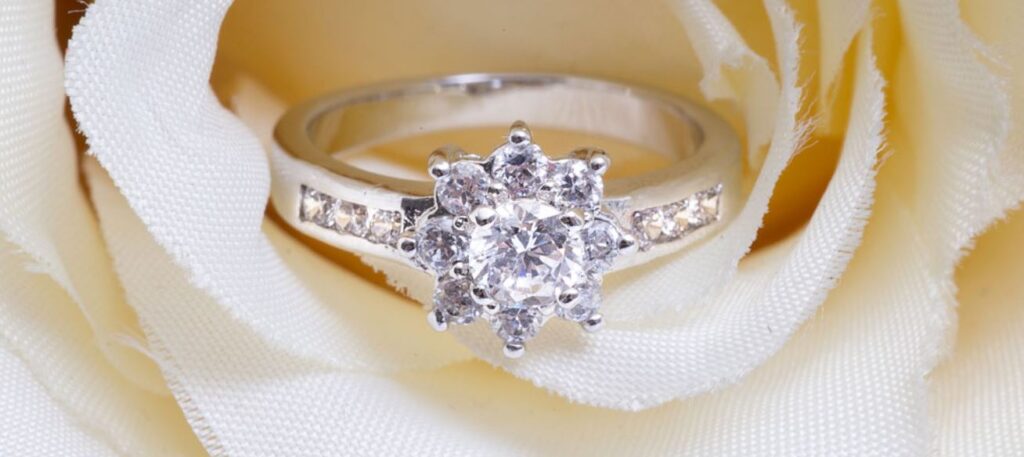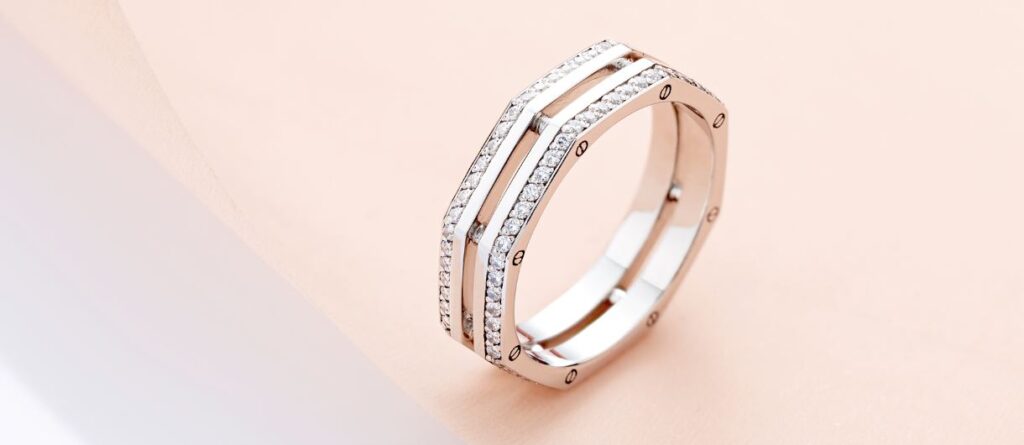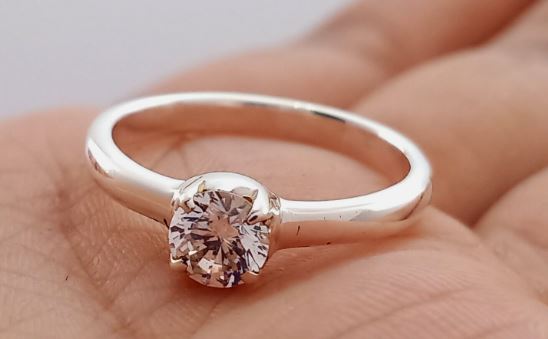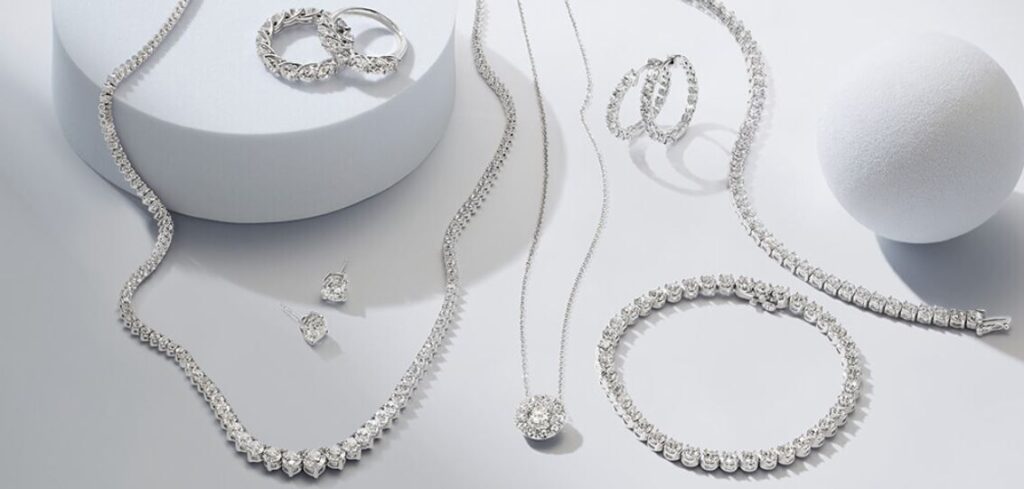What is White Gold
White gold means is an alloy of gold used in jewelry. It is made by combining gold with a white metal like platinum, nickel, palladium or zinc. White gold color is off white. It is one of the most premium white metals making it quite popular in jewelry.
White gold is a popular alloy of gold known for its white lustrous beauty and beautiful charisma for centuries. People have been using this type of gold in different jewelry items such as rings, necklaces, bracelets and anklets. One might wonder is it even real gold or just has the word “gold” in it.
That’s why in this article we’ll explain what is white gold, its composition, types, properties and what you should consider before buying white gold jewelry items.
Why Use White Gold
White gold is an alternative of rhodium or platinum in premium category. These two metals are either rare or really expensive for jewelry making. Platinum is a very dense metal which can take at least 14 to 15 grams to make a good sized ring. Contrary, same ring can be made in white gold with a weight of about 11 to 12 grams.
Though white gold is not as lustrous and shiny as platinum or rhodium but it can be a budget friendly option while remaining in the premium category. That’s why people use white gold as a good alternative of these metals.
White Gold vs Yellow Gold
White gold is an alloy made by combining pure gold with a white metal like platinum or zinc. Yellow gold is a gold alloy made by combining pure gold with copper.
Different Compositions of White Gold
White gold can come in a lot of different compositions. You simply need to mix a white metal with 24k pure gold to make it. And this white metal can be any metal including platinum, zinc, nickel or palladium. So, if you change the white metal type, final properties of white gold might change.
While nickel white gold might be rare due to its non-hypoallergenic properties, others are quite often used. Here are some of the compositions that are commonly used in jewelry making.
- Platinum White Gold
- Zinc White Gold
- Palladium White Gold
It must be noted that silver is not widely used in white gold.
White gold is a white colored gold alloy made by mixing pure 24k gold with other metals such as nickel or zinc. Both of these metals are white in color so they give an off-white hue and tint to the overall mixture known as white gold.
Mixing percentages can vary depending on properties and appearance needed from the end result. For example, if you want white gold to have enhanced hardness and whiter looks, nickel will be added in a greater percentages like 30%. Similarly if softness and yellowish tint of gold is desired, nickel will be added in lower quantities.
As per the addition of other metal, white gold can found in different purity levels such as 9k, 14k and 18k.

9k White Gold
9k white gold is made up of 37.5% gold and rest containing any other white metal like silver, nickel or palladium. It has the least purity among all leading to cheaper cost compared to other variants.
14k White Gold
14k white gold is the most popular variant of white gold which contains 58.5% gold and 41.5% nickel or silver. It has the optimum hardness level for jewelries like engagement rings, necklaces, bracelets etc. As it has more amount of gold in it, it has a greater cost than 9k white gold. If you’re buying white gold for its white lustrous beauty, then this is the purity level you should adopt.
18k White Gold
18k white gold is the purest form of white gold available in the market containing 75% gold and 25% nickel or silver. Due to high levels of gold, it does not have that much vibrant white color compared to the earlier discussed. With an overall yellowish tint, 18k white gold is best for ones who want a combination of yellow and white colors.

Properties of White Gold
White gold has a very unique set of properties compared to rose gold or yellow gold.
Appearance
We all know gold is its purest form has a bright yellow color. The whiteness of the white gold comes from the addition of nickel or cadmium. Both of these metals suppress the yellowish color of the gold and bring an off white color to the final alloy.
It is important to note that white gold is whiter than aregentium silver and has an off white color. The reason we see shiny bright surface is due to rhodium plating done over it.
Durability
White gold is a hard and durable metal for jewelry making. Addition of nickel makes gold harder and durable than before, so it can withstand small damages like scratches or dents. You can use white gold jewelry for your daily use without any problem.

Hypoallergenic Properties
White gold can be hypoallergenic. This is mainly caused by the addition of nickel metal with pure gold to bring a white color. If white gold is used in its lowest purity forms i.e. 9k, it will cause some skin problems to sensitive skins. An easy solution for this problem is to plate your white gold with rhodium plating. As long as rhodium plating doesn’t wear off, it will not allow nickel from white gold to react with your skin.
Cost
White gold is a much cheaper variant compared to yellow gold. Nickel is one of the cheapest metals available for jewelry making, that’s why the more nickel you add into white gold, more cheaper it gets. So, you can expect to pay far less for a 9k white gold jewelry compared to a 18k white gold jewelry.
Care and Maintenance
White gold needs some sort of care and maintenance from their owners. After all, this is for the better life of the jewelry. Regular cleaning is an important aspect of owning white gold jewelry. Avoiding cleaning with harsh chemicals is another point to be noted. Only use warm water with mild soap for cleaning purpose.
You can also visit your jeweler for a regular check up of your jewelry to keep it in its best possible condition. Jewelers generally do all the polishing and cleaning stuff for free if jewelry is bought from them.

How to Care for White Gold
Here are some tips for white gold care and maintenance.
1. Regular Cleaning
Regular cleaning is the foremost step of keeping the beauty and premium feeling of your white gold jewelry. Do regular cleaning with the help of mild soap and warm water. This can be done once in every 15 days if you’re a regular user. It is often recommended to clean your jewelry often a month but with premium metals, you should not take any chance of delaying it. Note that don’t over do it or it might scratch the jewelry.
2. Avoiding Harsh Chemicals
Harsh chemicals can be damaging for your jewelry. These chemicals often contain highly reactive compounds which instantly react with gold jewelry and leaving it with dull and non-shiny appearance. You need to avoid chemicals like detergents, bleach, washing powder etc. at all costs.
3. Using separate Storage
Separate storage is another great aspect to cater for. This keeps your jewelry from getting colliding with other jewelry items. You can use jewelry storage boxes for it with separate compartments for each jewelry.
4. Paying regular visits to jeweler
Jewelry can get damaged and you might not come to know. That’s why it is important to pay regular visit to your jeweler every 3 months. Jeweler will check your jewelry for any loose connections or potential damages. This will keep your jewelry safe in advance.

Other Types of Gold
Gold can be found in various compositions leading to different types on basis of color.
Rose Gold
Rose gold is a popular alloy of gold along with white gold. It contains a mixture of gold and copper where silver can also be added sometimes giving it a rosy color. Rose gold can also be found in various purity levels such as 9k, 14k and 18k. This alloy can be susceptible to tarnishing due to the presence of copper as the tarnishing effect not as strong as in sterling silver.
Yellow Gold
Yellow gold is the most common alloy of gold. All the yellow colored jewelry which you think is made of gold is actually yellow gold. It is composed of 24k pure gold and a combination of copper, silver and zinc. Main difference between rose gold and yellow gold is the percentage of copper used where rose gold contains more copper by weight than yellow gold.
Yellow gold is used in each and every jewelry you can think of. From necklaces to bracelets and rings, it can be found in each and every corner of the world.
Blue Gold
Blue gold is another variant of gold often linked to a more rarer and luxury form of alloys. It is created by mixing gold with any blue colored element like indium or gallium. For a better bluish color, this gold has to be made in least purity of gold i.e. 9k. In durability, this gold does not stand as much with other types of gold. It is very much prone to scratches.
Conclusion
White gold is an excellent choice of metals for ones who want premium feeling of gold with some unique attributes. It contains gold along with nickel or some other white metal. The goal here is to get the premium feeling of white metals at a lower cost. With buying white gold jewelry, you need to do proper care and maintenance of it as well. It includes regular cleaning, avoiding harsh chemicals, using separate storage and paying regular visits.

